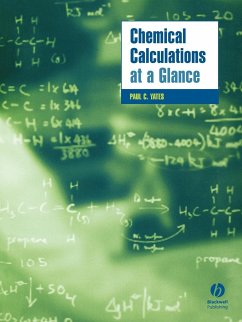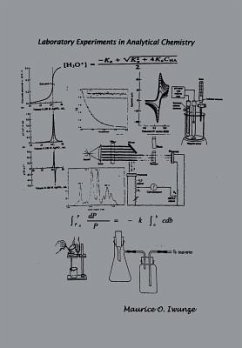
Calculations of Analytical Chemistry
Versandkostenfrei!
Versandfertig in 1-2 Wochen
39,99 €
inkl. MwSt.
Weitere Ausgaben:

PAYBACK Punkte
20 °P sammeln!
CALCULATIONS OF ANALYTICAL CHEMISTRY by LEICESTER F. HAMILTON, S. B. and STEPHEN G. SIMPSON. Originally published in 1922. PREFACE: The title of this book has been clfanged from Calculations of Quantitative Chemical Analysis to Calculations of Analytical Chem istry because the subject matter has been expanded to cover the stoichiometry of both qualitative and quantitative analysis. In order to include calculations usually covered in courses in qualitative analysis, some rearrangements of material have been made, new sections have been added, and chapters dealing with equilibrium constants and ...
CALCULATIONS OF ANALYTICAL CHEMISTRY by LEICESTER F. HAMILTON, S. B. and STEPHEN G. SIMPSON. Originally published in 1922. PREFACE: The title of this book has been clfanged from Calculations of Quantitative Chemical Analysis to Calculations of Analytical Chem istry because the subject matter has been expanded to cover the stoichiometry of both qualitative and quantitative analysis. In order to include calculations usually covered in courses in qualitative analysis, some rearrangements of material have been made, new sections have been added, and chapters dealing with equilibrium constants and with the more elementary aspects of analytical . calculations have been considerably expanded. Al together, the number of sections has been increased from 78 to 114 and the number of problems from 766 to 1,032. The greater part of the book is still devoted to the calculations of quantitative analysis. Short chapters on conductometric and amperometric titrations and a section on calibration of weights have been added, and many other changes and additions have been made at various points in the text. A section reviewing the use of logarithms has been inserted, and a table of molecular weights covering most of the problems in the book is included in the Appendix. It is felt that every phase of general analytical chemistry is adequately covered by problems, both with and without answers, and that most of the problems require reasoning on the part of the student and are not solved by simple substitution in a formula. LEICESTER F. HAMILTON STEPHEN G. SIMPSON CAMBRIDGE, MASS., February, 1947. Contents include: PREFACE v PART I. GENERAL ANALYSIS CHAPTER I. MATHEMATICAL, OPERATIONS 1. Factors Influencing the Reliability of Analytical Results 1 2. Deviation Measures as a Means of Expressing Reliability ... . 2 3. Significant Figures as a Means of Expressing Reliability 3 4. Rules Governing the Use of Significant Figures in Chemical Com putations 3 5. Conventions Regarding the Solution of Numerical Problems .... 6 Problems 1-18 7 6. Rules Governing the Use of Logarithms .... 9 7. Method of Using Logarithm Tables . . 13 8. Use of the Slide Rule 14 Problems 19-24 15 CHAPTER II. CHEMICAL, EQUATIONS 9. Purpose of Chemical Equations 16 10. Types of Chemical Equations 16 11. lonization of Acids, Bases, and Salts 17 12. Ionic Equations Not Involving Oxidation 18 13. Oxidation Number 20 14. Ionic Oxidation and Reduction Equations 21 Problems 25-43 24 CHAPTER III. CALCULATIONS BASED ON FORMULAS AND EQUATIONS 15. Mathematical Significance of a Chemical P^ ormula . 28 16. Formula Weights 28 17. Mathematical Significance of a Chemical Equation 29 Problems 44-70 32 CHAPTER IV. CONCENTRATION OF ^ SOLUTIONS 18. Methods of Expressing Concentration 36 19. Grains per Unit Volume 3f> vii CONTENTS 20. Percentage Composition. . . . . 36 21. Specific Gravity 36 22. Volume Ratios 37 23. Molar and Formal Solutions 37 24. Equivalent Weight and Normal Solution 38 25. Simple Calculations Involving Equivalents, Milliequivalents, and Normality 39 Problems 71-86 43 CHAPTER V. P] quiLiBRiUM CONSTANTS 26. Law of Mass Action 46 27. Ion Product Constant of Water 47 28. pll Value 48 Problems 87-94 49 29. lonization Constant 50 30. Common Ion Effect. Buffered Solution 52 31. lonization of Polybasic Acids 53 32.












